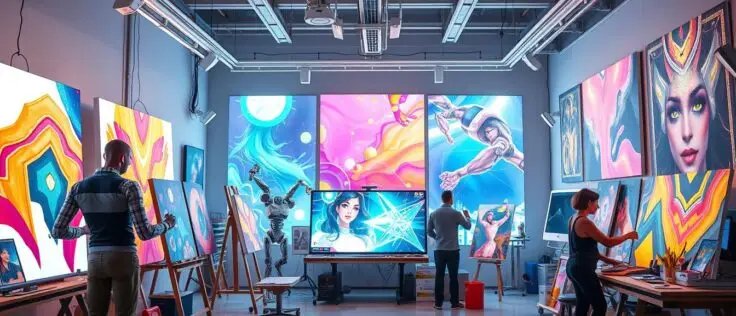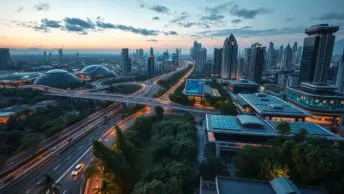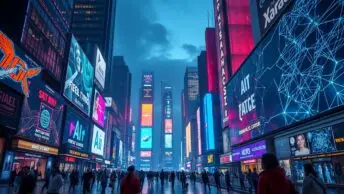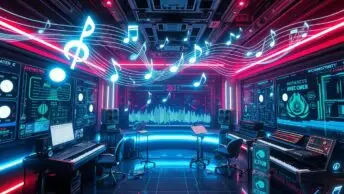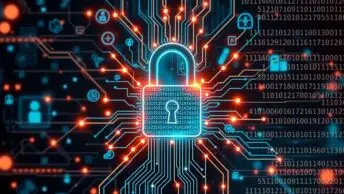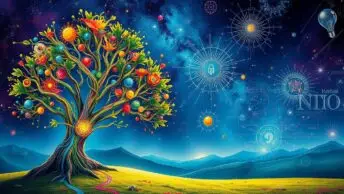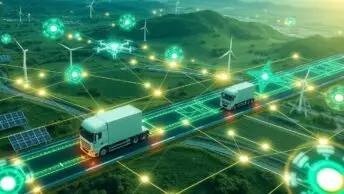Artificial Intelligence (AI) is changing the art world. It brings a new kind of creative innovation. As we look into AI Art, we see it challenging old ideas. It also opens up new possibilities for Artistic Expression and Digital Art. This new age lets creativity use the quick and precise power of neural networks. Thus, it pushes human imagination into new areas.
Generative Adversarial Networks (GANs) and advanced AI algorithms aren’t just ideas from science fiction anymore. Now, they create artworks so lively and captivating they make us wonder if they’re made by humans or machines. These technological wonders use data to create paintings and sculptures as good as those made by people1. In music, AI studies a wide range of songs. Then, like a skilled musician, it makes symphonies from classical to modern music12.
Today, art and technology are closely linked. AI helps artists by suggesting new ideas, styles, and themes1. It frees artists from dull tasks like image editing and sound mixing. This boosts efficiency and lets them focus on creating art1. AI-made artworks have caught people’s attention. Some have even sold for a lot of money. This shows they’re valued and have an impact1.
AI isn’t just for making art. It also helps people enjoy and understand art better. Tools like Google’s Arts & Culture use AI to make discovering and interacting with art easier. It invites people to learn about different artistic traditions and histories2. AI in art and creative industries is creating a space where technology meets human creativity. This leads to growth and endless new chances.
AI Advancements in Generative Art
AI has transformed the art world, especially in generative art, creating a new era for creativity. AI artists use neural networks to turn ideas into real pieces of art. This shift comes from combining algorithms and artists’ visions.
Understanding Generative Adversarial Networks (GANs)
Generative Adversarial Networks (GANs) lead this artistic change. They have two models: one creates art, the other reviews it. This improves the artwork’s quality and realism. GANs learn from huge datasets, enhancing and sometimes surpassing human art creation. They’re key in the future of generative art.
Case Studies: AI Masterpieces Mimicking Human Artists
The sale of “Portrait of Edmond de Belamy” for $432,500 highlights AI art’s value1. This sale proves AI-generated art’s worth and its place in modern art
The Impact of Neural Networks on Creative Expression
Neural networks change how artists make art. They let AI analyze and learn from past art, making unique pieces that respect traditional forms1. These tools help artists quickly make and improve their work2. Technologies like virtual reality show how neural networks can offer new artistic experiences1.
The Intersection of AI Art and Creativity
AI Artists are more than just digital innovators. They blend advanced tech with human creativity, pushing Digital Art further. With tools like Generative Adversarial Networks (GANs), they’re transforming art and creativity3. AI in art challenges old views, making way for new artistic journeys.
Embracing AI in art means being responsible. As McLuhan said, each tech reflects its values. Engaging with AI Art on shared platforms helps in understanding its impact5. This is essential for keeping artistic integrity.
To understand AI’s role in content marketing in more detail, explore how AI-driven content marketing is changing strategies in the UK.
AI's Contribution to Music Composition and Sound Design
Technology and creativity have evolved together, placing AI at the core of today’s music and sound design. AI musicians and sound designers are now key in the music industry. They are breaking new ground and redefining possibilities.
Algorithms Behind AI-Composed Symphonies
Neural networks, like recurrent neural networks (RNNs) and long short-term memory (LSTM) networks, are used in AI music6. These advanced models learn from large datasets of diverse music to mimic complex patterns6. Companies such as Amper Music, AIVA, and Google’s Magenta lead the way, creating new music in various styles using these technologies6.
The Symbiosis of AI and Human Musicians
AI musicians are complementing human creativity, not replacing it. They offer composers and performers endless new soundscapes and textures. AI makes music production reachable for those without formal training, which opens up music creation to more people6. This leads to unique collaborations where AI music is refined by humans, adding emotional depth and artistic touch.
Exploring Diverse Musical Landscapes through AI
Fostering Innovation in Art through Machine Creativity
Machine creativity is changing the art world, making it easier and better. Artists can now push past old limits with AI help. This adds precise and efficient new tools to their process.
How Machines are Refining Artistic Techniques
AI Algorithms as a Source of Creative Inspiration
AI Tools That Enhance the Artistic Workflow
AI Artists and the New Wave of Digital Art
AI artists lead the digital art revolution, blending tech skill with creative vision. Their work brings digital art to new heights, showing how art and AI tech are now closely linked. Artistic exploration in the digital realm is redefining art, making us rethink how we create and view it.
Transformative AI Technologies in Art Generation and Reception
AI technologies have changed the art world dramatically. They not only change how art is made but also how people see and interact with it.
Personalisation and AI in Audience Art Experience
AI has greatly improved how art is created, making personalised art experiences possible. Museums and galleries now use AI to learn what visitors like. This helps them show art that people will enjoy more12. This has also led to a new market for digital and AI-generated art that people buy and sell as NFTs. It’s changed how art is owned and traded in a big way12.
Real-time AI Interaction Shaping Artistic Narratives
AI’s role in art is not just about making static pieces. It encourages people to be part of the story. AI lets art change in response to what viewers do, creating it together. This makes people feel closer to the art and allows the art to grow with each interaction. For example, AI installations at shows can change theme and style based on how people feel. This shows how fluid art influenced by AI can be13.
Enhanced Accessibility to Art Through AI Innovations
AI has made art more accessible to more people, no matter where they are or if they have physical challenges13. AI helps create virtual art experiences that can be enjoyed online from anywhere. AI also helps understand which artworks grab people’s attention. This helps those who curate and create art to reach and influence more people13.
In summary, AI has changed how art is made and curated. It has also changed how people experience and see art. These changes mean more people can enjoy art, have personalised experiences, and be part of changing art stories. AI innovations are starting a new chapter in the art world.
Reimagining Creative Processes with AI Integration
AI is changing how we think and carry out creative work. It boosts our work speed and brings in new ideas that were hard to find before. Now, artists can achieve things they couldn’t when only using old ways.
A New Paradigm for Artistic Workflows
Artificial intelligence is making big changes in how art is made by adding automation. It uses advanced programs to do art tasks that are boring or take a lot of time. This lets artists do more thinking and coming up with ideas1-k-k-k>. This teamwork between artists and AI helps them grow and try new things1-k-k-k>,2-k-k-k>. As artists teach AI their styles, they can make art that is very personal. This opens up new possibilities for creativity14
Automation of Mundane Tasks to Foster Creativity
AI takes over the boring parts of making art. This gives artists freedom to think and create in new ways. It affects both the making and the thinking behind art, filling both with creativity. Using AI means artists can make complex pieces faster, showing how critical AI is today1-k-k-k>15,
The art world keeps getting into AI, and it’s showing us its big potential. By using tools like digital editing and 3D printing, there’s a big change happening. It’s moving us to a future where tech and creative thinking mix well together14
Challenges and Ethical Implications of AI in Creativity
Artificial Intelligence (AI) is growing fast in the creative world. But this growth brings challenges and ethical questions. We need to look closely at the ethics of AI in creativity. This includes the importance of copyright and keeping the human element alive.
Navigating Copyright Complexities in AI-Generated Content
Copyright issues are a big worry with AI in creativity. There’s a lot of debate about who owns AI-made content. UNESCO is working on global standards for AI ethics. This is to help deal with these issues16. There’s also a big push for AI systems that are clear and can be explained. Artists want to know how AI helps their work16.
Preserving the Essence of Human Touch Amidst Technological Change
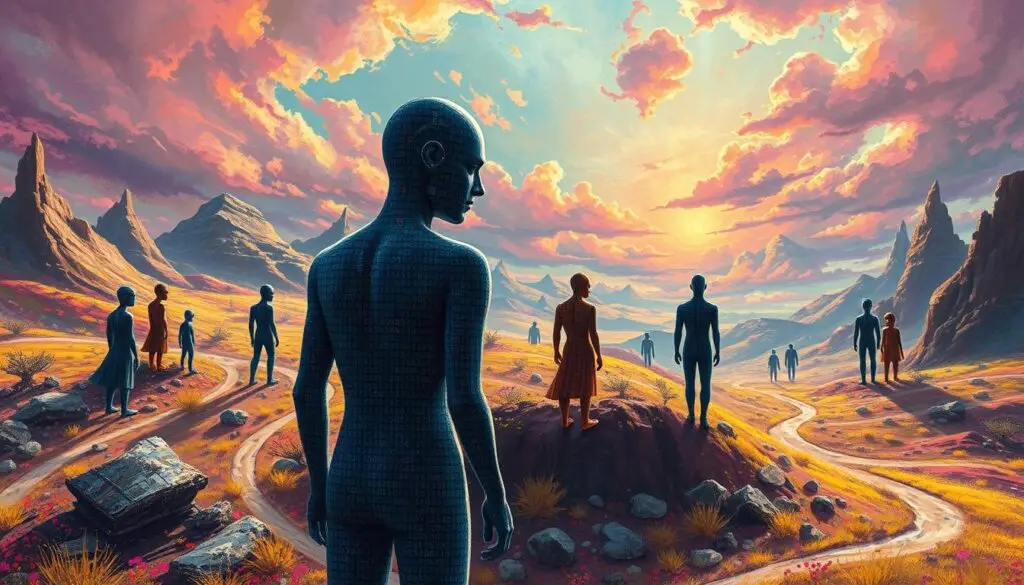
Conclusion
The journey of AI Art and Creativity is truly groundbreaking. It traces back to Harold Cohen’s AARON and peaks with Artificial General Intelligence in 201218. This new era blends history with the present, reminding us of geniuses like Leonardo da Vinci and Andy Warhol. They saw art and technology as partners18. The sale of ‘Edmond de Belamy’ at Christie’s for $432,500 shows AI’s big impact in both business and culture19.
Machine Creativity has expanded the scope for creativity in art. It’s thanks to the high-end algorithms from Google Brain and OpenAI19. AI is reshaping Digital Art, changing how artists work and opening doors to new kinds of creativity18. Yet, debates on AI missing emotional depth and originality continue. These discussions resemble those for any major art innovation20.
The clash between AI and human creativity is leading us to an exciting era. It’s where tech precision and human quirks could create new Artistic Expression. As art turns into ‘content’, telling good from bad art gets tricky. It makes both creators and viewers rethink what value means today20. Still, there’s hope for a future where tech and human creativity merge. This could spark not just new art forms but redefine art’s core1819. In this new world, AI is not just a tool. It’s an active creator and enjoyer of art, ready to revolutionize our art experience. The story of AI in art is evolving, filled with questions and discoveries, as it crafts a fresh language for artistic exchange that includes both tech and human elements.
FAQ
What is AI Art?
AI Art is artistic works made with Artificial Intelligence’s help or solely by it. This includes using algorithms and learning methods like GANs. They help create everything from pictures to music pieces.
How are Generative Adversarial Networks (GANs) used in art creation?
In art, GANs work by having two neural networks compete: one makes new images, and the other reviews them. The process goes on until these art pieces look like a person made them. This method greatly enhances creative art making with machines.
Can AI replicate the quality of art created by human artists?
Indeed, AI has created art that stands up well against human-made art. With the growth of AI, it’s becoming hard to tell them apart. AI can now imitate human creativity very closely.
What role does AI play in music composition and sound design?
For music and sound, AI studies patterns in massive music collections to make new pieces. It uses algorithms to craft music in many styles. This gives musicians new tools to widen their horizons.
How does AI provide creative inspiration to artists?
AI inspires by showing new ways, shapes, and patterns to artists. By looking through lots of data, it finds new combos. Thus, it gives artists fresh ideas and designs to spark their creativity.
How are AI Artists influencing the digital art scene?
AI Artists mix algorithmic detail with creative flair, sparking a revolution in digital art. Their work is creating new definitions and possibilities for digital creativity.
In what ways does AI enhance the audience’s art experience?
AI makes art experiences better by tailoring suggestions to what you like. It allows art to evolve based on viewer input. This makes art more immersive and interesting.
How does AI impact the creative processes of artists?
AI shakes up the creative process by doing routine or hard tasks, giving artists more creative time. This makes work flow better and boosts innovation chances.
What are the main ethical implications of using AI in creativity?
Ethical concerns with AI in creativity cover copyright and who owns AI-made content. It’s crucial that AI’s role doesn’t lessen the importance of the human element in art.
How does AI impact copyright issues in the creative industries?
AI stirs copyright debates by making content that tests old rules. Who owns an AI piece—the algorithm’s maker, the user, or the AI—is hotly debated. This calls for new policies.
Source Links
- AI and Creativity: Exploring the Role of Artificial Intelligence in Art and Music – https://medium.com/@mohsinali73a/ai-and-creativity-exploring-the-role-of-artificial-intelligence-in-art-and-music-3b6defa689b3
- The Role of AI in Art and Creativity: How is AI changing the landscape of creative industries? – https://www.linkedin.com/pulse/role-ai-art-creativity-how-changing-landscape-creative-stanley-russel-jiqgc
- AI and Creativity its Intersection in Art and Music – https://krct.ac.in/blog/2024/04/26/ai-and-creativity-its-intersection-in-art-music-and-literature/
- Art by Algorithm: Exploring the Intersection of AI and Creativity – https://medium.com/@tomdausy/art-by-algorithm-exploring-the-intersection-of-ai-and-creativity-6a47692d8d02
- Exploring the intersection of art and AI: A journey through the future of creativity process – https://bootcamp.uxdesign.cc/exploring-the-intersection-of-art-and-ai-a-journey-through-the-future-of-creativity-process-1e9cd7f3d982
- How AI Helps in Music Composition: Revolutionizing Creativity and Production – https://www.evoastra.com/post/how-ai-helps-in-music-composition-revolutionizing-creativity-and-production
- Harnessing Creativity: The Power of AI Art in Unlocking Human Potential – https://www.linkedin.com/pulse/harnessing-creativity-power-ai-art-unlocking-human-i7kpe
- AI and Machine Creativity: How Artistic Production Is Changing – https://knowledge.wharton.upenn.edu/article/ai-and-machine-creativity-how-artistic-production-is-changing/
- Is generative AI really a threat to creative professionals? – https://www.theguardian.com/technology/2022/nov/12/when-ai-can-make-art-what-does-it-mean-for-creativity-dall-e-midjourney
- Unlocking Artistic Potential: The Magic of AI Art Software – https://lifestyleforreallife.com/2024/01/10/ai-art-software/
- Pixels and Paint: How AI Drives a New Wave in Contemporary Art? – https://fadmagazine.com/2024/05/15/pixels-and-paint-how-ai-drives-a-new-wave-in-contemporary-art/
- Part 2: Impact of AI Art on the Art Industry – https://medium.com/@zafchow/part-2-impact-of-ai-art-on-the-art-industry-26d2cee77263
- How AI is Transforming Creative Processes – https://dragonflyai.co/resources/blog/how-ai-is-transforming-creative-processes
- AI-Generated Art: How Can Visual Artists Navigate This New Frontier of Creativity? – https://artmarketingnews.com/ai-generated-art/
- Reimagining Imagination – https://medium.com/@wisak_/reimagining-imagination-a615c79c216a
- The ethics of using AI for creativity: Opportunities and challenges – https://www.linkedin.com/pulse/ethics-using-ai-creativity-opportunities-challenges-stefan-holitschke
- AI and the Future of Art: Ethical Considerations for Creativity – https://medium.com/@jamesgondola/ai-and-the-future-of-art-ethical-considerations-for-creativity-84ea06fc4eff
- Ai & Art – revolutionizing creativity or threatening tradition? – https://www.linkedin.com/pulse/ai-art-revolutionizing-creativity-threatening-tradition-hamsic-igyre
- Is AI-generated art actually art? – https://www.plymouth.ac.uk/discover/is-ai-generated-art-actually-art
- Why AI Will Never Rival Human Creativity – https://www.persuasion.community/p/why-ai-will-never-rival-human-creativity
